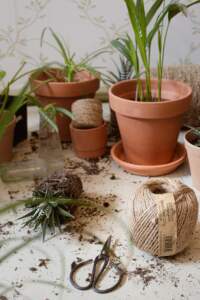Smart plant parents know that watering and situating your plant in the optimum spot for correct lighting are only Step 1 and 2 of proper care. Houseplants outgrow their pots. Knowing when – and how – to repot your plant is important. Why? A larger pot allows more space for roots to expand, plus additional soil adds essential nutrients to a plant’s environment.
Repotting too soon can sometimes harm a plant, especially if it’s in a period of slow growth or dormancy. Here’s what we recommend:
AS IN ALL ASPECTS OF LIFE – TIMING IS EVERYTHING
 The first time to repot your plant is a few weeks after bringing it into your home. Plastic nursery pots are not recommended for long-term growth. The transition from nursery to home can be stressful for a plant. You’ll know when it’s time to transfer into a more spacious pot when you see your plant grow one to three new leaves.
The first time to repot your plant is a few weeks after bringing it into your home. Plastic nursery pots are not recommended for long-term growth. The transition from nursery to home can be stressful for a plant. You’ll know when it’s time to transfer into a more spacious pot when you see your plant grow one to three new leaves.
Repotting is also necessary when a plant starts outgrowing its home. Roots growing out of a pot’s drainage hole is a clear sign it’s time for a change. The pot should generally be ⅓ of the plant’s total height from the ground level. If the plant itself makes up more than ⅔ of the height, it’s time to repot. Remember, not all plants grow taller, some grow fuller or longer.
Water pooling on top of the soil is another sign a plant needs repotting. Cramped plants do not absorb as much water if there’s not enough soil. Plants that need repotting also may drop larger, older leaves each time a new leaf sprouts.
Try to repot a growing plant about once a year, but more frequently for plants that grow quickly, like Monstera deliciosa, Pothos and Philodendron.
Time of year doesn’t particularly matter, though many houseplants grow more slowly in the winter, so they may not need repotting during that time.
HOW TO CHOOSE YOUR PLANT’S NEW POT
Select a new pot that’s one to two inches larger in diameter than the current one. Look for pots with bottom drainage holes to help prevent root rot. If you select a pot without holes, add a layer of volcanic rock. This prevents the plant from sitting in water for long periods.
Most houseplants will thrive in easy-to-find potting mixes.
GET ‘ER DONE
We suggest you do the transfer outside, or cover your work space surface with a drop cloth. 
- Gather your new pot and fresh soil.
- If you’re using rocks at the bottom, add enough to fill the bottom quarter of the pot, then cover with a layer of fresh soil. Otherwise, simply add soil to the bottom of the pot.
- Pack the bottom tightly, then add a looser layer of soil on top to adjust the height of the plant.
- Turn the plant on its side.
- As you hold the base of the pot, carefully jiggle the plant out. Do it gently to avoid breakage.
- Get rid of as much of the old soil as possible.
- Use your fingers to untangle the bottom inch or two of the roots. (This will stimulate the plant’s growth hormones.)
- Set the plant on top of the soil in the new pot, and pour new soil around it while holding it in place, packing lightly with your fingers as you pour. (You’ll know the soil is tight enough when you can put some weight on top and your fingers don’t disappear into the soil.)
- Leave an inch or two between the top of the soil and the rim of the pot.
- Give your newly repotted plant a good watering.
Of course, the final step is watching your plant thrive in its new home. A little care goes a long way, and reaps beautiful rewards. Enjoy!
Check out our selection of plant pots here.


